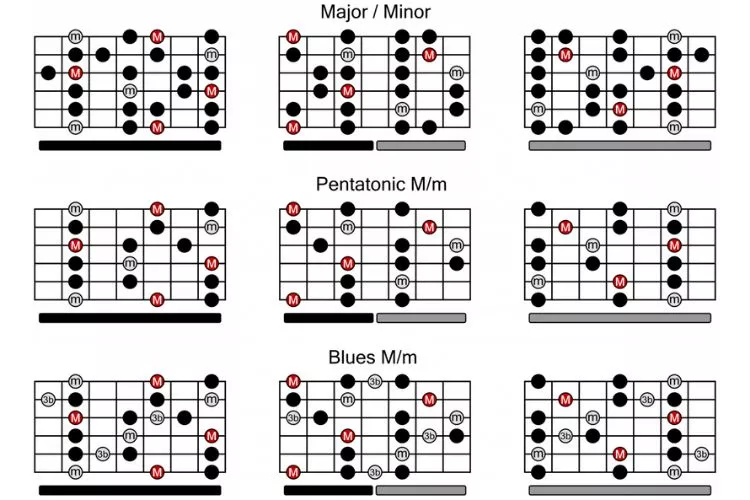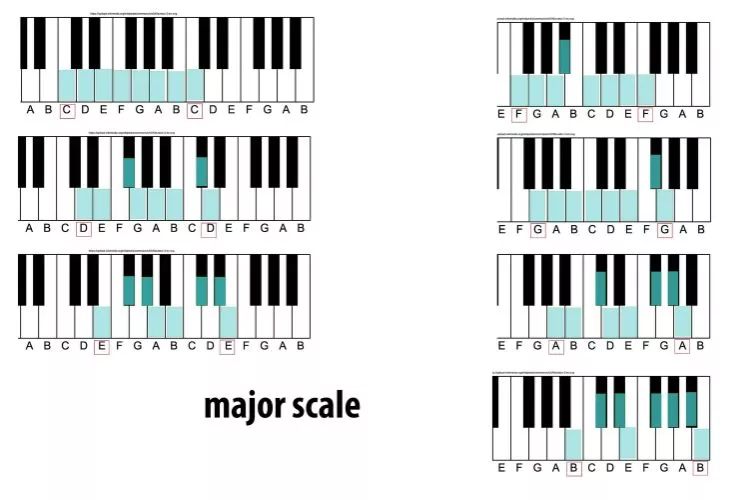Music is a universal language that speaks to our souls, evoking emotions and connecting people across cultures. Behind every memorable melody lies a fundamental building block – the music scale.
In this comprehensive guide, we will delve into how many scales are there in music, uncovering their types, construction, and practical applications.

From the familiar major and minor scales to the more exotic pentatonic, blues, and chromatic scales, we will unveil the secrets of these musical treasures.
Contents
🎶how many scales are there in music?
Major Scales
The major scale is one of the most commonly used scales in Western music. It is known for its bright and cheerful sound, evoking a sense of optimism and happiness.
The major scale follows a specific pattern of whole and half steps, creating a unique sequence of intervals.
Understanding the construction of major scales is essential for musicians and songwriters alike, as it provides a solid foundation for creating harmonious melodies.
Minor Scales
In contrast to the major scale’s uplifting sound, the minor scale evokes a sense of melancholy and introspection. It is often associated with emotional depth and sadness.
Similar to the major scale, the minor scale also follows a pattern of whole and half steps, albeit with some slight variations. Exploring the construction and application of minor scales unlocks a whole new world of musical expression.
Other Types of Scales
Beyond the major and minor scales, there is a vast realm of scale types waiting to be discovered. These scales offer unique tonalities, allowing musicians to explore different sounds and create diverse musical expressions.
Let’s dive deeper into some of these intriguing scales.

Pentatonic Scale
The pentatonic scale is a five-note scale that is widely used in various music genres, including folk, blues, rock, and pop. This scale provides a versatile foundation for improvisation and composition.
Its distinct characteristic is the omission of the fourth and seventh notes from the corresponding major or minor scales. This omission creates a more ambiguous and open sound that lends itself well to creating memorable melodies.
The pentatonic scale is known for its ability to evoke emotions and capture listeners’ attention with its simplicity and recognizable patterns.
Blues Scale
As a variation of the pentatonic scale, the blues scale adds a “blue” note to the standard pentatonic formula. This additional note often referred to as the “flat fifth” or “blue” note, adds an element of tension and gives the scale its distinct bluesy sound.
The inclusion of this note infuses a sense of melancholy and expressiveness, embodying the essence of blues music. The blues scale has been crucial in shaping the genre, as it allows musicians to create soulful melodies and powerful improvisations.
Chromatic Scale
The chromatic scale is unique in that it encompasses all twelve semitones within an octave. This scale includes every pitch available within the Western musical system.
As a result, the chromatic scale offers the most versatility for creating intricate and expressive melodies. It is often utilized in jazz, classical, and avant-garde compositions to add richness and complexity.
While the chromatic scale can sound dissonant or unresolved in isolation, its purpose is to provide a vast pool of possibilities for musical exploration and expression.
Non-Western Scales
Music traditions outside of the Western world also have their own unique scales, adding cultural diversity and complexity to the world of music. For instance, Indian classical music employs a system of scales known as ragas.
Each raga has its specific set of ascending and descending notes, providing a framework for melodic improvisation and emotional expression. The Arabic maqam scales, on the other hand, are used in traditional Middle Eastern music.
These scales offer a wide range of microtonal intervals, allowing for highly nuanced melodic ornamentation and evocative emotions.
Exploring these different scales opens a gateway to diverse musical idioms. By incorporating these scales into their compositions or improvisations, musicians can expand their artistic horizons and create captivating and unique musical experiences.
The versatility of these scales enables artists to craft melodies that resonate deeply with audiences across various genres and cultures.
It is worth noting that this overview only scratches the surface of the countless scales found throughout the world. From the ancient modes of ancient Greece to the intricate scales of Eastern music, the diversity and richness of scales are truly boundless.
As you continue your musical journey, embrace the opportunity to uncover new scales and incorporate them into your playing, composing, and improvisations.
The possibilities are endless, and the rewards are immeasurable. So, seize the chance to discover the hidden gems of scales and let their magical tones inspire your musical creativity.
🎶What is the 12 music scale?
The 12 music scale refers to the chromatic scale, which encompasses all twelve semitones within an octave.
It includes every pitch available within the Western musical system, giving musicians a broad range of possibilities for creating intricate and expressive melodies.

The chromatic scale is particularly prominent in jazz, classical, and avant-garde compositions, where its inclusion allows for chromaticism and intricate harmonic progressions.
🎶What is the highest scale in music?
The highest scale in music can vary depending on the context. In terms of pitch, the highest scale achievable is generally limited by the vocal range or the capabilities of the instruments being used.
For example, in vocal music, the highest scale is typically determined by the uppermost notes a singer can comfortably reach. In instrumental music, the range depends on the specific instrument.
However, it is worth noting that the melodic possibilities of scales can extend into higher octaves or even beyond the audible range, as contemporary techniques often explore extended techniques and unconventional sound production.
🎶How many major scales are there?
In Western music, there are a total of 12 major scales. Each major scale is based on a specific starting note or tonic, and the pattern of whole and half steps remains consistent throughout the scale.
These 12 major scales cover every possible key within the Western musical system.

Understanding the concept and construction of major scales is fundamental for musicians, as it provides a solid foundation for understanding harmony, chord progressions, and melodic composition.
🎶What are the hardest scales in music?
The difficulty of scales can be subjective and dependent on individual skill levels and familiarity with different scale types. However, certain scales are commonly regarded as challenging due to their technical demands or complex patterns:
- Chromatic Scale: The chromatic scale is demanding due to its inclusion of all twelve semitones, requiring precise fingering and coordination. Mastery of this scale requires excellent technical control and finger dexterity.
- Diminished Scale: The diminished scale consists of alternating whole and half steps, creating a symmetrical pattern. Its complex structure makes it challenging to navigate and improvise over, demanding a thorough understanding of its harmonic implications.
- Whole-Tone Scale: The whole-tone scale consists entirely of whole steps. Its lack of half steps and distinctive sound make it a challenging scale to utilize effectively. Melodies and harmonies within the whole-tone scale can sound ambiguous and floaty, requiring careful consideration in their application.
- Phrygian Dominant Scale: The Phrygian Dominant scale is commonly used in jazz and fusion music. It combines elements of the Phrygian mode and the harmonic minor scale, resulting in an exotic and challenging scale to master, particularly when improvising.
While these scales may present technical challenges, they also offer exciting opportunities for musicians to expand their skills and explore new musical territories.
You may also find useful: Top 10 Exercises to Improve Piano Technique
🎶What scale do most musicians use?
The most commonly used scale in Western music is the major scale. Its bright and cheerful sound makes it versatile and well-suited for a wide range of musical genres and applications.
Many songs, melodies, and harmonies are based on the major scale, making it an essential scale for musicians to understand and utilize in their compositions, improvisations, and arrangements.

The major scale serves as a foundation for music theory, chord progressions, and understanding the relationships between different notes and keys.
Its ubiquity and familiarity make it a fundamental scale choice for musicians across various genres and skill levels.
🎶Pro Tips
Mastering Scale Practice: To truly understand scales, it is important to practice them regularly. Start by playing scales slowly, focusing on accuracy and correct fingerings. Gradually increase the speed as you become more comfortable. Additionally, try practicing scales in different keys and patterns to develop versatility in your playing.
Incorporating Scales into Improvisation: When improvising, don’t be afraid to experiment with different scales and modes. Understanding the relationship between scales and chords will enable you to make informed melodic choices that create tension and resolution within your solos.
Songwriting with Scales: Scales provide a treasure trove of melodic possibilities in songwriting. Experiment with different scales to create unique and memorable melodies. Combining scales with chord progressions can help evoke various emotions and moods in your compositions.
🎶frequently asked question (FAQs)
In Western music, scales typically consist of seven notes, or pitches, within an octave. However, some scales, like the pentatonic scale, have five notes, while others, like the chromatic scale, contain all twelve semitones.
Absolutely! Scales provide a framework for improvisation by outlining the notes that are harmonically compatible with a given key or chord progression. Understanding scales enables musicians to create spontaneous and captivating solos.
No, scales are essential for all musicians, regardless of their chosen instrument. Singers, for example, can use scales to warm up their vocal range and improve their pitch accuracy. Scales also play a crucial role in understanding music theory and composition.
Conclusion:
Understanding the vast array of music scales opens up boundless possibilities for musicians and songwriters. From the comforting familiarity of major and minor scales to the adventurous exploration of pentatonic, blues, and chromatic scales, each scale type adds a distinct flavor to the musical palette.
Whether you’re starting your musical journey or seeking to deepen your understanding, embracing the world of music scales will undoubtedly enhance your appreciation of this universal art form. So, grab your instrument, warm up those vocal cords, and let the exploration begin.
